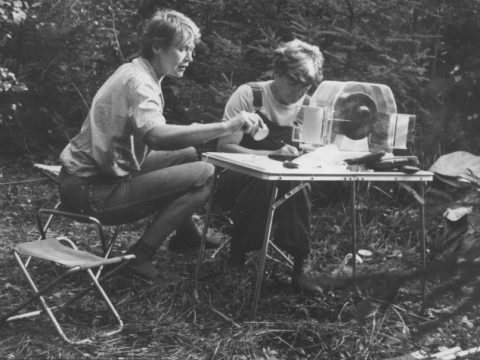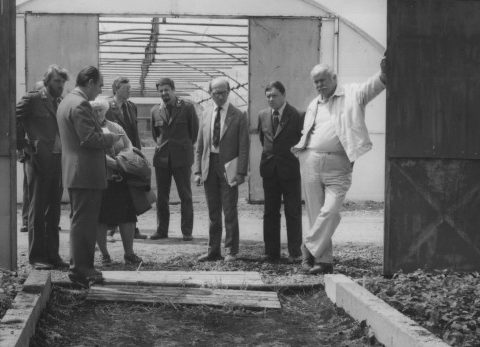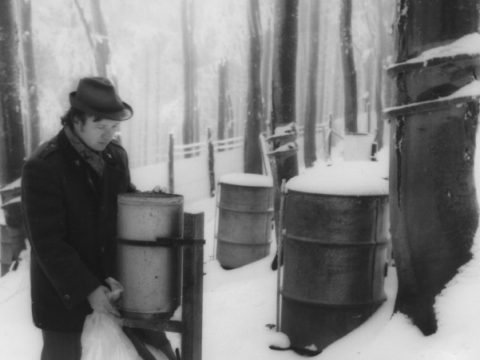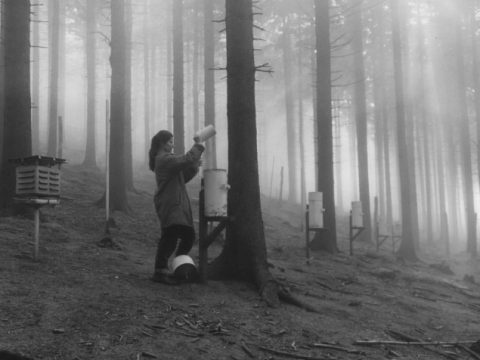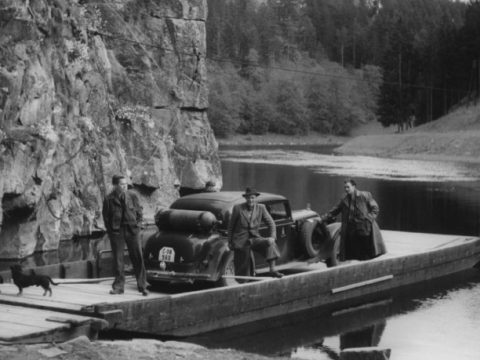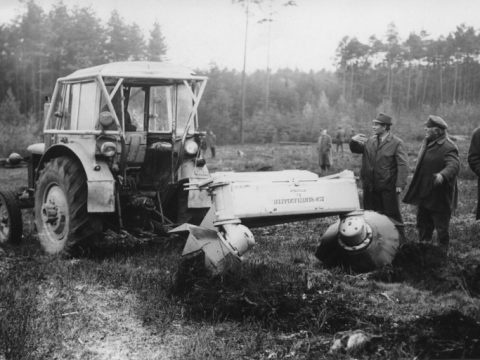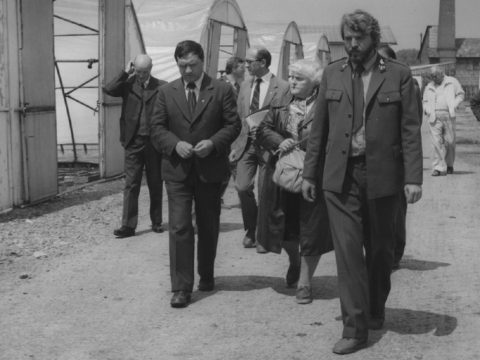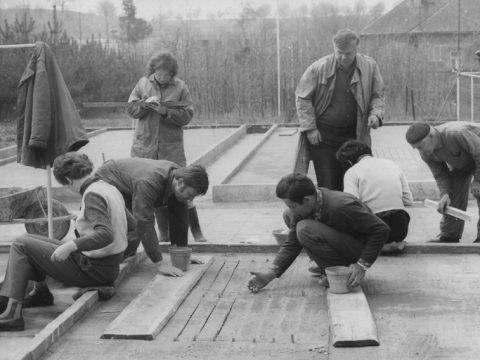A new Research institute for silviculture, seed management and forest nursery practice was established at Opočno in February 28, 1951.
Two important facts existed for that choice. There is an old directorate of the Forest enterprise at Opočno. That enterprise had a long-standing tradition and number of notable foresters worked there. Hugo Konias was the most famous forester who as a forest counsel and a later director of the Colloredo-Mansfeld´s manor at Opočno substantially influenced forest management of this region. He had used modern ways of forest management on vast area of 4,500 ha from 1924 and fetched the broad forestry community by his work.
The second account for the Research institute founding represented a newly formed Forest enterprise at Opočno (combined the manor at Opočno and a part of the manor at Rychnov n. Kn.) with an area of 10,000 ha of national forests and of 2,900 ha of forests under special administration. Those forests were located in three forest regions called lowland Polabí, Foothill of the Orlické hory Mts., and the Orlické hory Mts. with altitude ranged from 250 m to 1,100 m. Almost all forest vegetation altitudinal zones and forest-type groups appeared in the Czech Republic are present on that relatively small territory. There are both Scotch pine sites in riparian forest stands on Pleistocene terraces along the Divoká Orlice River and Norway spruce sites on ridges of the Orlické hory Mts.
By the decision of the Ministry of agriculture, water and forest management, the Forest enterprise at Opočno as an experimental enterprise was added to the Research institute. The investigations and use of new methods were brought namely into forests of that enterprise. At that time, the main goal was to increase the use of mechanization means both in logging and in silvicultural practices. In 1959, the Experimental forest enterprise at Opočno was separated from the Research institute and was included into the County administration of forests in Hradec Králové. The change led to disruption of some research plots and to reduction of long-term examination of new silvicultural methods because of different interest of the Forest enterprise in harvesting methods when the clear-cutting method was preferred.
In 1951, the Research institute was localized in the partially adapted building near to the castle at Opočno and in 1952, it was included in branch Research institute of forest management at Zbraslav-Strnady as a Research station of silviculture. Besides chiefs Ing. J. Mottl and Hugo Konias, the investigation body was formed by the other workers: Ing. Pavel Matoušek, Ing. Karel Kaňák, Bohumil Švarc and three young workers Ing. Vratislav Dušek, Luděk Chroust a Theodor Lokvenc who became the base of following research team. In 1956, Ing. Vladimír Peřina was designated as a chief of the Research station and he led that station up to 1990. Already in 1958 the research body grew up to 28 workers when 10 of them were graduated.
From establishing the Research institute at Opočno in 1951, Hugo Konias was a reputable special worker of that station. He concentrated on conversion of pure even-aged stands into mixed uneven-aged stands fitted site conditions. Solving conversions became the main research project at the time after founding the Research station. Hugo Konias offered also a wide consultancy. He taught Ing. Vladimír Zakopal, who assisted him, and later became his follower.
The Research station offered the wide-ranging consultancy from the beginning. Older foresters could remember the well-known “Opočno silvicultural courses”, which stretched over 3 to 5 days. These courses were organized regularly. More than 6,000 practical foresters (native and foreigners) and 3,000 forest students took part in them in a period of 1951 to 1959.
Many well-known forest scientists gained their special profile in the Research Station at Opočno through its 50 years history, most of them use their ability on the next scientific workplaces and schools in the Czech Republic and also abroad. Although the remarkable results in a shelterwood management represented initial motivation for foundation of the Research station at Opočno, the extent of solved problems increased during the time. The whole silviculture from forest nursery management to reforestation, tending and regeneration was stepwise covered by the research activities. Those activities also covered the next regions of the Czech Republic.
The opening a new research and laboratory building increased investigative possibilities (the building was opened on the 3-rd of October 1964). Research workers refined their work in a specialized section of forest nursery and reforestation and in a section of forest regeneration and tending.
The section of forest nursery dealt with biological aspects of plants cultivation. The research solved lot of nursery management problems (introduction of modern technology into nurseries, undercutting of roots, cultivation of containerized plants and others). The nursery team also dealt with the problems of technical tree species cultivation. These species were to replace some raw materials, which could not be imported due to embargo. There were mainly eucalyptus tree species, when at their cultivation the remarkable results in their biology and possibilities of their cultivation in our conditions were found. The research was stopped because of new import resources of eucalyptus oil.
The forest regeneration in severe conditions (frost hollows in a highland of the Českomoravská vrchovina Mts., heavily weeded salvage clear-cuts, plots above timberline and others) was the next sphere of research. Investigation concentrated on using various containerized seedlings and plants in connection with reforestation of extreme localities and also with interest in increasing quality of plantation. The other activities run in solving problems of desiccants and antitranspirants used for transpiration reduction, problems of differentiation of reforesting methods, and problems of selection of planting stock according to forest type groups. Herbicides and arboricides were also tested in connection with site preparation.
The specific project represented management of poplars and bole willows; this was motivated by the demand for wood-production enlargement in the forest stands and plantations. Investigation of indigenous poplars assortment was done in frame of the Forest enterprise at Opočno. Technology of plantations and cultivation of poplars were tested, permanent plots with poplars were founded for monitoring of species and clones suitability in certain localities. Maintenance breeding and propagation of plus trees found out common marks of individual clones. The solution of this project together of its researcher Ing. J. Mottl, CSc. passed over to the Research station at Kostomlaty – Uherské Hradiště in the late 50´s.
The research projects of forest regeneration firstly concentrated on the natural regeneration. The essence of this research was to study structure and development of advanced growths in relations to typological-site units, undergrowth synusia, and regeneration fellings. The attention was paid to conversion from high forest, regenerated by a clear-cut or an opening, to selective one. This investigation continued on former Hugo Konias` workareas. The examinations dealt with volume increment and with increasing of valuable assortment portions of beech and oak and with total volume production of broad-leaved stands. Ample observations were aimed at regeneration of spruce, fir and beech in third, fifth and sixth altitudinal forest vegetation zones, which represent more than one half of forest area in the Czech Republic.
The research of forest tending was from the beginning directed to young growths. The research plots were founded in pine, oak and spruce stands in the typical localities, and the most of plots were again placed on the area of the Forest enterprise. The influence of tending on growth and differentiation of stand environment were also studied on those plots.
The important changes of research orientations started after growing influence of immission in the forests. The Research station began to solve the problem in 1959. Research concentrated on the therapy of damaged stands by tending. The first plots were established in Trutnov area, where the stands were damaged by power stations Rtyně and Trutnov – Poříčí. Attention was also paid to increasing injuries in the Sudety Mountains (Krušné hory, Jizerské hory, Krkonoše, Orlické hory).
Increasing influence of immissions in the 70´s and 80´s basically modified most of research projects, mainly projects dealing with reforestation, tending and regeneration. The majority of research capacities were aimed at mountain areas with forests damaged by immissions. Silvicultural research was entered with research of ecological and environmental forest functions from 60´s. Namely research of hydrical and hydrological effectiveness of forest ecosystems and its management has been studied from 70´s. Need of investigation of forest amelioration as a whole brought Doc. Peřina to create its section in 1987.
Forest research in the areas damaged by immissions also dominated in the last decade. The problems were solved in the project ” Stabilization of wood- and non-wood production functions” together with the other cooperated organizations in the term 1990 – 1995. From 1995 the research of silvicultural problems was concentrated to the branch research project “Silviculture in ecotopes disturbed by human activities”, which was interested in forest regeneration and tending in areas damaged by immissions and by next human activities. The research project was transformed to a new long-term research project under the name “Stabilisation of forest functions in anthropically disturbed and changing environmental conditions” and it has continued until the present time.
Primary resource: (Sach & Jurasek)

